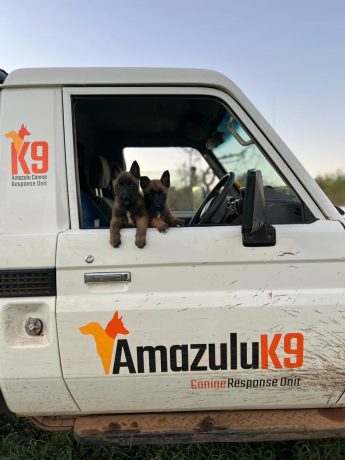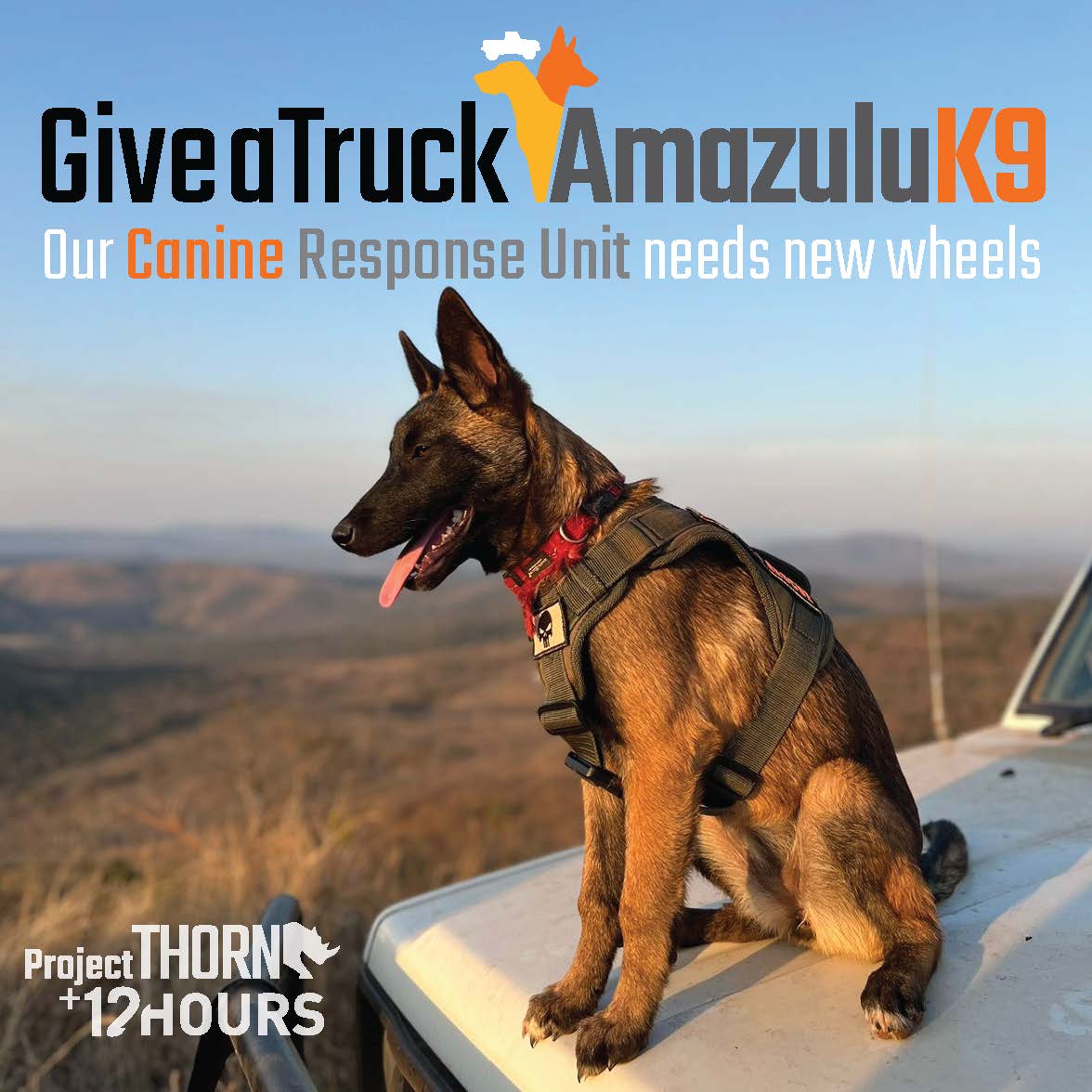

Give a Truck – Why?
Motivation for Give a Truck
The canines many of you helped to purchase in 2022 have been incredible effect. The year prior to their presence on the reserve 20 rhino were killed and 11 were injured by poachers. In the 15 months since the canines have been on patrol, the reserves have only lost 1 rhino to poachers. Those numbers are remarkable.
With the initial funding for ConservationK9 we agreed to get the program up and running. This included purchasing, training and certifying the canines, training and certification of the handlers, all the equipment the canines needed (gps collars, harnesses, leads, etc.), building kennels, modifying an existing vehicle for safe canine transportation, and a year of vet care.
The vehicle they have been using is a 20+ year-old Landcruiser. After 400,000 km of hard driving through rugged bush lands it is in need of significant repairs – so many that the investment in repairs no longer makes sense. They are in need of a new, reliable patrol vehicle.

Who, When, Where, Why, and How
In South Africa, a daily life and death battle is being fought between wildlife rangers and animal poachers. Rangers are committed to the protection and conservation of the rhino population – while the poaching syndicates are invested in the species extinction. The recent rapid growth in rhino being poached for their horn is alarming. Our focus at ProjectThorn is to provide on-the-ground, tangible solutions to prevent poaching – we know canines can make a difference – now.


The Canines are located on a reserve in Northern KwaZulu-Natal, South Africa. However, they will be utilized by a collection of reserves that cover an area of 50,000 hectares (125,000 sq acres – roughly twice the size of Point Reyes National Seashore). They are also deployed throughout the Pangola area when needed.
Northern KwaZulu-Natal (KZN) borders Estwatini (formally Swaziland) and Mozambique. With the increased security in Kruger National Park and the Greater Kruger Region, KZN has been particularly hard hit by poaching syndicates. Proximity to International borders make this specific region particularly vulnerable. Combined with the downturn in International Tourism due to Covid, independent reserves (which do not receive government support) are struggling to maintain protection for the wildlife.

We have great urgency to act as quickly as possible. Rhino are important to protect and the species is at a critical tipping point.
Rhino are keystone herbivore species. The grazing habits of the white rhino allow biodiversity to flourish in the entire savanna ecosystem.
They
have roamed the planet for 40 million years. If poaching rates continue on the current trajectory they are at risk of becoming extinct in the
wild in the next decade. Humans are their only natural predator. We can prevent their demise.
Recent exponential growth in rhino poaching is alarming! The mass slaughter of rhinos has increased for the 15 th year in a row all for profits/greed and the fictitious belief in the healing powers of their horns (the horns are keratin – the same as your finger nails and hair).
Who doesn’t love a baby rhino? The video is generously provided by Paul Mills. Follow Paul’s channel on YouTube
By choosing to protect an apex species, we protect all the other species in the park as well.
Poachers are opportunistic and will poach what is available whether that be an Elephant for its ivory, or a Pangolin for its scales. Even endangered endemic plants are poached.


While there are various methods to combat poaching, canine patrols are one of THE most effective and efficient methods to detect incursions into reserves, locate snares, and track poachers. Their noses see things that are invisible to a ranger’s eyes.
Photo: While on a walking patrol, the dogs located this snared warthog. Unfortunately, we arrived too late to save this warthog, but the 2 incursion on the fence line set with snares, ready to capture the next animal to pass through, were also located by the canines before any animals were injured.
Snares kill indiscriminately and cruelly.
South Africa is home to 83% of the world’s rhino population and is the epicenter of the rhino poaching crisis.
The canines have proven themselves in the 15 months they have been on the reserve. In fact they have been so effective that they have added 2 more Malinois to the pack. The unit is now comprised of 2 Malinois, 1 shepard, and a cold scent hound.
We have an established relationship with 12 Hours, a non-profit organization with a track record in coordinating rhino conservation efforts.
AmazuluK9 (formally ConservationK9 was born out of 2 experiences. Karrie was volunteering with Cheetah Conservation Botswana (CCB) in 2019, where she worked with their canine program. They utilized a canine specifically trained to locate cheetahs and their scat to help monitor the cheetah population and track injured animals. Canines were also placed with local farmers to help protect their goat herds from being preyed upon by cheetah. Cheetah Conservation learned that dogs where significantly better at protecting the goats than their human owners so they implemented a program to train canines and give them to the local farmers.
After leaving Botswana, intrigued by the ability of the CCB canines, Karrie arranged to meet the trainers at K9 Conservation in Hoedspruit to learn more about their process. She ended up staying for days. From Karrie – “It was truly remarkable to see how efficient and effective the canines are. In 1 hour we walked 1 fenceline, the canine located 2 incursion points where poachers entered the property and found a snare. Snares are indiscriminate. They catch whatever animal is unfortunate to be the first to tread along the path after the snare is set. I also had the good fortune to take part in a tracking exercise. In the early morning hours the trainers sent out a person to lay a scent trail then to remain hidden in a tree. After several hours the dogs where given the scent to find and follow. They were instantly on the trail and had located the person within 30 minutes. I expect it would have been even faster had they not had us humans holding them back”

Above: Loeto is the first mixed breed Tswana dogs that Cheetah Conservation Botswana trained specifically to locate Cheetah spoor for the research team.
Below: A Tswana dog placed with a farm family to herd the goats

The illegal poaching trade is booming. The primary market for rhino horn is Southeast Asia, where a recently promoted, completely erroneous perception that rhino horn has medicinal value, drives demand. (The rhino horn is made of keratin and has no medicinal value.)
Rhino horn is one of the world’s most expensive commodities – $66,000/kilo* – and is worth more than gold, diamonds, or cocaine. The scarcity being driven by poaching is also creating a market for speculative investment in extinction. The illegal trafficking of endangered species is the 4th most lucrative global crime after drugs, human trafficking and weapons. It is well documented that illegal wildlife poaching and trade funds terrorism.
* this reported number fluctuates dramatically from source to source. 65-66,000$/kilo was the widely accepted as the price for rhino horn prior to the covid pandemic. According to WildAid the value has dropped by two-thirds. Unfortunately, poaching has not experienced the same significant drop. There is reason to be optimistic that if indeed the price has dropped as dramatically as reported by WildAid, that it may indication a weakening demand. With less demand and a lower financial incentive to poach hopefully poachers will be discouraged from seeking a big PayDay by killing a rhino.
Please check the ConservationK9 FAQ page. If you don’t see your questions there, please send us and email and info@projectthorn.com
